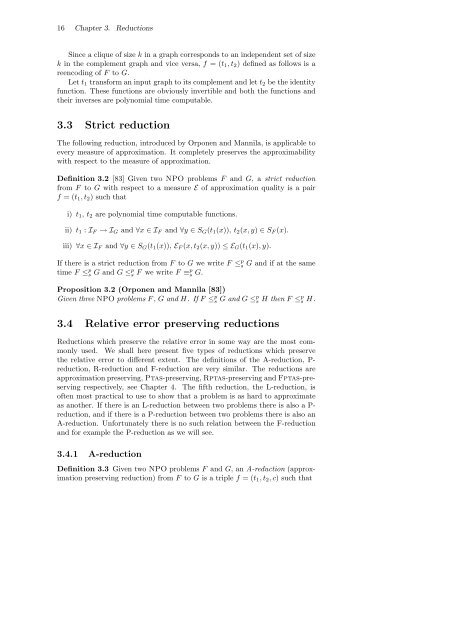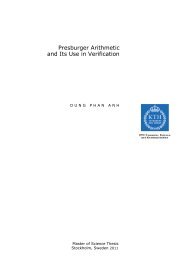On the Approximability of NP-complete Optimization Problems
On the Approximability of NP-complete Optimization Problems
On the Approximability of NP-complete Optimization Problems
Create successful ePaper yourself
Turn your PDF publications into a flip-book with our unique Google optimized e-Paper software.
16 Chapter 3. Reductions<br />
Since a clique <strong>of</strong> size k in a graph corresponds to an independent set <strong>of</strong> size<br />
k in <strong>the</strong> complement graph and vice versa, f =(t1,t2) defined as follows is a<br />
reencoding <strong>of</strong> F to G.<br />
Let t1 transform an input graph to its complement and let t2 be <strong>the</strong> identity<br />
function. These functions are obviously invertible and both <strong>the</strong> functions and<br />
<strong>the</strong>ir inverses are polynomial time computable.<br />
3.3 Strict reduction<br />
The following reduction, introduced by Orponen and Mannila, is applicable to<br />
every measure <strong>of</strong> approximation. It <strong>complete</strong>ly preserves <strong>the</strong> approximability<br />
with respect to <strong>the</strong> measure <strong>of</strong> approximation.<br />
Definition 3.2 [83] Given two <strong>NP</strong>O problems F and G, astrict reduction<br />
from F to G with respect to a measure E <strong>of</strong> approximation quality is a pair<br />
f =(t1,t2) such that<br />
i) t1, t2 are polynomial time computable functions.<br />
ii) t1 : IF →IG and ∀x ∈IF and ∀y ∈ SG(t1(x)), t2(x, y) ∈ SF (x).<br />
iii) ∀x ∈IF and ∀y ∈ SG(t1(x)), EF (x, t2(x, y)) ≤EG(t1(x),y).<br />
If <strong>the</strong>re is a strict reduction from F to G we write F ≤p s G and if at <strong>the</strong> same<br />
time F ≤p s G and G ≤p s F we write F ≡p s G.<br />
Proposition 3.2 (Orponen and Mannila [83])<br />
Given three <strong>NP</strong>O problems F , G and H. IfF ≤ p s G and G ≤p s H <strong>the</strong>n F ≤p s H.<br />
3.4 Relative error preservingreductions<br />
Reductions which preserve <strong>the</strong> relative error in some way are <strong>the</strong> most commonly<br />
used. We shall here present five types <strong>of</strong> reductions which preserve<br />
<strong>the</strong> relative error to different extent. The definitions <strong>of</strong> <strong>the</strong> A-reduction, Preduction,<br />
R-reduction and F-reduction are very similar. The reductions are<br />
approximation preserving, Ptas-preserving, Rptas-preserving and Fptas-preserving<br />
respectively, see Chapter 4. The fifth reduction, <strong>the</strong> L-reduction, is<br />
<strong>of</strong>ten most practical to use to show that a problem is as hard to approximate<br />
as ano<strong>the</strong>r. If <strong>the</strong>re is an L-reduction between two problems <strong>the</strong>re is also a Preduction,<br />
and if <strong>the</strong>re is a P-reduction between two problems <strong>the</strong>re is also an<br />
A-reduction. Unfortunately <strong>the</strong>re is no such relation between <strong>the</strong> F-reduction<br />
and for example <strong>the</strong> P-reduction as we will see.<br />
3.4.1 A-reduction<br />
Definition 3.3 Given two <strong>NP</strong>O problems F and G, anA-reduction (approximation<br />
preserving reduction) from F to G is a triple f =(t1,t2,c) such that

















